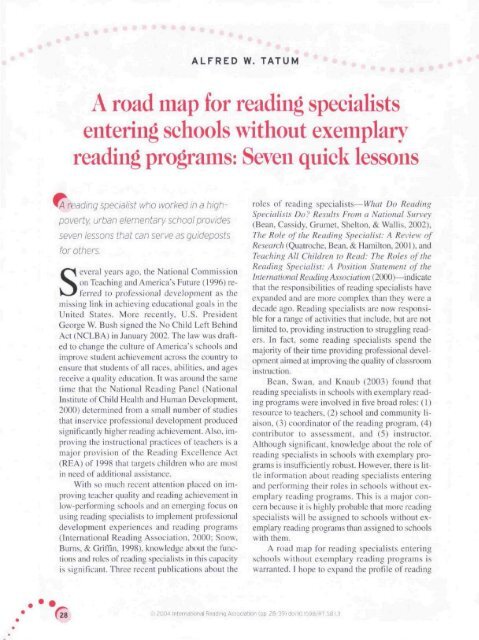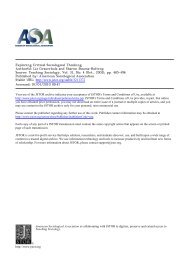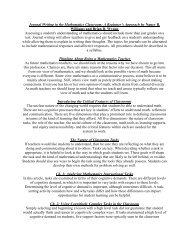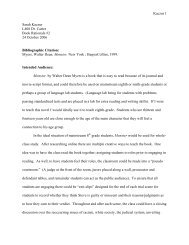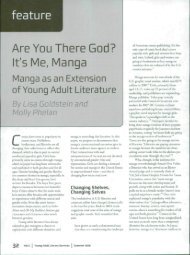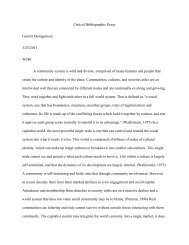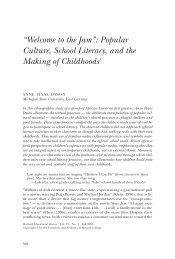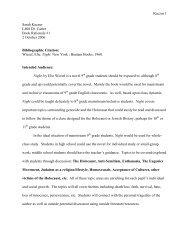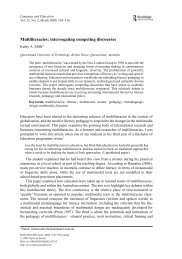A road map for reading specialists entering schools ... - Oncourse
A road map for reading specialists entering schools ... - Oncourse
A road map for reading specialists entering schools ... - Oncourse
You also want an ePaper? Increase the reach of your titles
YUMPU automatically turns print PDFs into web optimized ePapers that Google loves.
ALFRED W. TATUMA <strong>road</strong> <strong>map</strong> <strong>for</strong> <strong>reading</strong> <strong>specialists</strong><strong>entering</strong> <strong>schools</strong> without exemplary<strong>reading</strong> programs: Seven quick lessons^A <strong>reading</strong> specialist who worked in a highpoverty,urban elementary school providesseven lessons that can serve as guideposts<strong>for</strong> others.Several years ago. the National Commissionon Teaching and America's Future (1996) referredto professional development as themissing link in achieving educational goals in theUnited States. More recently. U.S. PresidentGeorge W. Bush signed the No Child Left BehindAct (NCLBA) in January 2002. The law was drafledto change the culture of America's <strong>schools</strong> andimprove student achievement across the country toensure that students of all races, abilities, and agesreceive a quality education. It was around the sametime that the National Reading Panel (NationalInstitute of Child Health and Human Development,2000) determined from a small number of studiesthat inservice professional development producedsignificantly higher <strong>reading</strong> achievement. Also, improvingthe instructional practices of teachers is amaior provision of the Reading Excellence Act(REA) of 1998 that targets children who are mostin need of additional assistance.With so much recenl attention placed on improvingteacher quality and <strong>reading</strong> achievement inlow-per<strong>for</strong>ming <strong>schools</strong> and an emerging focus onusing <strong>reading</strong> <strong>specialists</strong> to implement professionaldevelopment experiences and <strong>reading</strong> programs(International Reading Association. 2000; Snow.Bums. & Griffin. 1998). knowledge about the functionsand roles of <strong>reading</strong> <strong>specialists</strong> in this capacityis .significant. Three recent publications about theroles of <strong>reading</strong> <strong>specialists</strong>—What Do ReadingSpecialists Do? Results From a National Survey(Bean. Cassidy. Grumet. Shelton. & Wallis. 2002),The Role of the Reading Specialist: A Review ofResearch (Quatroche. Bean. & Hamilton. 2(K)1}. andTeaching All Children to Read: The Roles of theReading Specialist: A Position Statement of theInternational Reading Association (2000)—indicatethat the responsibilities of <strong>reading</strong> <strong>specialists</strong> haveexpanded and are more complex than they were adecade ago. Reading <strong>specialists</strong> are now responsible<strong>for</strong> a range of activities that include, but are notlimited to, providing instruction to struggling readers.In fact, some <strong>reading</strong> <strong>specialists</strong> spend themajority of their time providing professional developmentaimed at improving the quality of classroominstruction.Bean. Swan, and Knaub (2003) found that<strong>reading</strong> <strong>specialists</strong> in <strong>schools</strong> with exemplary <strong>reading</strong>programs were involved in five b<strong>road</strong> roles: (1)resource to teachers. (2) school and community liaison.(3) coordinator of the <strong>reading</strong> program. (4)contributor to assessment, and (5) instructor.Although significant, knowledge about the role of<strong>reading</strong> <strong>specialists</strong> in <strong>schools</strong> with exemplary programsis insufficiently robust. However, there is littlein<strong>for</strong>mation about <strong>reading</strong> <strong>specialists</strong> <strong>entering</strong>and per<strong>for</strong>ming their roles in <strong>schools</strong> without exemplary<strong>reading</strong> programs. This is a major concernbecause it is highly probable that more <strong>reading</strong><strong>specialists</strong> will be assigned to <strong>schools</strong> without exemplary<strong>reading</strong> programs than assigned to <strong>schools</strong>with them.A <strong>road</strong> <strong>map</strong> <strong>for</strong> <strong>reading</strong> <strong>specialists</strong> <strong>entering</strong><strong>schools</strong> without exemplary <strong>reading</strong> programs iswarranted. I hope to expand the profile of <strong>reading</strong>® 2004 International Reading Association (pp 28-39) doii0.l598/RT.58.1.3
<strong>specialists</strong> generated by Bean et ul. {2003) by sharingseven lessons from my experience as a <strong>reading</strong>specialist in a school with a chronic pattern of lowliteracy achievement, a school that initially did nothave an exemplary <strong>reading</strong> program. I bring attentionto how a cohesive system of professional developmentsupport was framed.My de.scription of <strong>reading</strong> <strong>specialists</strong> movesbeyond the existing data in several ways. Whilemost of the current research brings attention to<strong>reading</strong> <strong>specialists</strong> working with students in the primarygrades. I focus on a <strong>reading</strong> specialist workingwith teachers of students in grades 4-8 in anurban school in the United States where more than95% of the students were eligible <strong>for</strong> free orreduced-cost lunch. The description considers ab<strong>road</strong>er conceptualization of the role of <strong>reading</strong><strong>specialists</strong> working toward schooiwide <strong>reading</strong>achievement. It also moves beyond the traditionalpull-out model or in-class model when the <strong>reading</strong>specialist collaborates with the classroom teacher.Focus is placed on the role of the <strong>reading</strong> specialistas a teacher leader in an environment characterizedby a high percentage of students <strong>reading</strong>below grade level. Finally, I propose a direct linkbetween the support of a <strong>reading</strong> specialist and improved<strong>reading</strong> achievement in the school.The context of the schoolI was a <strong>reading</strong> specialist at Radnus Elementary(pseudonym), an urban K-S elementary school with450 students. All of the students were AfricanAmerican. The school suffered from a pattern oflow achievement in both <strong>reading</strong> and mathematics.Ten years ago. 1^/c of the students were <strong>reading</strong> at orabove national norms as reflected by data from theIowa Test of Basic Skills (ITBS). By 1996. the percentageof students <strong>reading</strong> at or above nationalnorms was 13%. Radnus was one ol the lowest per<strong>for</strong>mingelementary <strong>schools</strong> in its large urbanschool district. At that time the school was placedon academic probation by its district's Office ofAccountability.The school was assigned a probation managerwho served as a liaison with the Oftlce of Accountability.A mentor principal joined the faculty, andthe school was given external support from an educationalorganization that worked with staff toimprove student achievement. By the 2001-2002school year and after t1ve years of additional discretionaryfunding <strong>for</strong> the external support partner.ITBS test data indicated that 18% of the studentswere <strong>reading</strong> at or above national norms. It was atthis time that the school's principal sought helpfrom a local university administrator who had extensiveexperience leading professional developmentef<strong>for</strong>ts to improve students' <strong>reading</strong> achievement. Toestablish a plan of action <strong>for</strong> supporting the teachers,the university administrator conducted four halfdays of observation in the school. She observed thata large majority of the teachers relied on test preparationmaterials to raise students' standardized testscores. In most classrooms <strong>reading</strong> instruction consistedof filling in blanks in workbook pages, checkingthe pages by <strong>reading</strong> aloud orally, andround-robin oral <strong>reading</strong>.The university administrator recommendedimplementing a schooiwide literacy frameworkthat included daily read-alouds. guided <strong>reading</strong> instruction,independent <strong>reading</strong>, word study, andwriting. This approach was largely derived from researchon effective elementary teachers (Allington.2002: Pressley. 1998: Wharton-McDonald et al..1997). To move the implementation <strong>for</strong>ward, twocertified <strong>reading</strong> <strong>specialists</strong> with more than 25combined years of experience in urban educationwere hired as part of a University Partnership Team(UPT). The <strong>reading</strong> <strong>specialists</strong> were supported by auniversity grant-funded project and the school'sdiscretionary funds. Although the UPT worked collaborativelyon schooiwide issues. I was hired tosupport eight teachers in grades 4-8 as they implementedthe literacy framework, and I functionedprimarily as a teacher leader.After the teachers and I worked together <strong>for</strong>19 months they were able to increase schooiwide<strong>reading</strong> achievement. By the end of school year2001-2002, 26^^ of the students were <strong>reading</strong> ator above national norms, up from 18%. ITBS data indicatedgains in the percentage of students <strong>reading</strong>at or above grade level <strong>for</strong> all grades 4-8. The largestgains were from the seventh- and eighth-grade studentswhere a more detailed case study of profes-.sional development was being conducted. At thebeginning of school year 2001-2002, 22'^ of theseventh-grade students {n = 28) and 21 % of theeighth-grade students (/? = 33) were <strong>reading</strong> at orabove national nomis. By the end of the school yearA <strong>road</strong> nuip<strong>for</strong> rcadinii si)cciatisis cnCcriui^ scltools \Z'ithim[ cxcnijihiry rcadiuii
TABLE 1Gains and losses using Iowa Test of Basic Skills standard scoresThe scale score was used because it is an equal-unit scaie extending from the lowest achievement in kindergarten tothe highest achievement in grade 12. Scale scores were developed so that progress can be followed over a period ofyears. They are used primarily <strong>for</strong> statistical analysis, such as obtaining and calculating gains.Grade45678Average gains**12 (14)6(13)7 (12)*25(11)33 (11)'Muitipie teacher changes**The number in parentheses is the approximate average growth from one grade to the next in <strong>reading</strong> in standard scoreunits.the percentages increased to 39% and 57%. respectively.ITBS standard scale scores indicated that studentsin grade 4 were close to achieving nationalaverage gains, while students in grades 7 and 8 surpassednational average gains. The gains of the studentsin grades 5 and 6 were not as large (see Table1).Negotiating a situational IdentityI entered Radnus Elementary in the middle ofschool year 2000-2001. The principal introducedme during a staff meeting as an "expert" on <strong>reading</strong>who was going to get the school off "probation."For two weeks, I engaged in a process Angrosinoand Mays de Perez (2000) referred to as "role making"to become familiar with the culture of theschool and to determine how best to proceed withthe teachers. This role making was critical to thedevelopment of my identity as a <strong>reading</strong> specialistbecause I did not '*step into [a] fixed and fully definedposition" (p. 683).During the first six months, I had access to theteachers' classrooms and their teaching. I observedthat the teachers were not implementing some ofthe recommended teaching practices, continuinginstead to inundate students with test preparationmaterials. I met with teachers individually and ingroups. I repeatedly expressed my consternationabout their instructional practices during individualconferences and grade-level meetings. There wasresistance. I was locked out of one teacher's classroom.Another teacher walked out of the classroomas I was modeling a lesson. The interactions of thefirst six months were tenuous, causing me to reflecton my ability to move the teachers toward change.Being close to the students' failures created inme a desire to <strong>for</strong>ce teachers to change their instructionalpractices. Kohn (1999) referred to thisas the "arrogance of top-down coercion" whenthose outside the classroom decide what the peoplein it are required to do. However, I determined thatit was <strong>for</strong> the best to persuade teachers that thecourse of instruction I advocated was the one totake. There<strong>for</strong>e, I had to find ways to negotiate myidentity (Angrosino & Mays de Perez, 2000) withthe teachers that would allow them to receive thesupport I could provide.Aligning function as <strong>reading</strong>specialist with school contextI recorded notes of my ef<strong>for</strong>ts over the first sixmonths in a weekly reflection log. My analysis ledme to conclude that my support lacked a cleartheoretical head. I had focused only on instructionto improve students' <strong>reading</strong> achievement. Theteachers needed more support to implement the literacyframework. I assessed that the followingsteps were needed to align my role as <strong>reading</strong> spe-The Reading Teacher Vol. 58, No. 1 September 2004
FIGURE 1Anatomy of professional development supportHead1. Characteristics ofeffective teachingof African Americanstudents2. Changing concept ofadolescentiiteracyRadnus iiteracy framework(Refiected best practices in <strong>reading</strong>/literacy education)Body1. Read-aiouds2. Guided <strong>reading</strong> (BDA)3. independent <strong>reading</strong>4. Word study/vocabulary5. WritingLegsReadingspecialistK-3Resources1. Human2. MaterialsReadingspecialist4-8Resources1. Human2. Materialscialist with the school context:• Provide professional development supportthat is anatomically complete (see Figure 1).• Discuss factors that include, but arc not limitedto, instructional practices that have the potentialto improve students' <strong>reading</strong> achievement.• Provide teachers with the physical supportsand materials <strong>for</strong> instructing the students.I expanded my role as <strong>reading</strong> specialist beyondthe initial literacy framework to align my ef<strong>for</strong>tswith the needs of the teachers and students atRadnus Elementary. Lyons and Pinnell (2001) suggestedthe need <strong>for</strong> literacy programs with a cohesivesystem (i.e., an arrangement of things sointimately connected that they <strong>for</strong>m a unifiedwhole greater than the sum of their parts). Usingthe idea of a cohesive system, I examined threebodies of literature as being intimately connectedand necessary to frame my role as <strong>reading</strong> specialistat Radnus Elementary. Understanding of the students'culture and literacy in.struction specifically<strong>for</strong> adolescents were placed at the core of the enhancedsupports (see Table 2).There were several reasons <strong>for</strong> this b<strong>road</strong>erframing. First, teachers of African American studentsfrom impoverished urban communities oftenhave students with a wider array of developmentalskills and cultural barriers than do other teacherswho are not similarly situated (Louis & Miles.1990}. This problem is exacerbated when teachersA <strong>road</strong> <strong>map</strong> <strong>for</strong> <strong>reading</strong> spvcialisis <strong>entering</strong> <strong>schools</strong> witlKnit cxvmpUiry I'cailinfi prof^rums
Educating AfricanAmerican studentsLegitimate African Americanstudents' culture and makeit a reference <strong>for</strong> learning.Resist curricuiumorientations that stifle orpostpone academic growth.Engage students in authenticdiscussions where theycan analyze their realitiesin the context of thecurriculum and discussstrategies <strong>for</strong> overcomingacademic and societalbarriers.Guide students towardacademic success andculturai competence.Address students' cognitive,affective, social, emotionai,and developmental needs.Require students to meethigh academic standards.TABLE 2Three bodies of literatureTeacher professionaldevelopmentEstablish a strong conceptualbasis when impiementing theprofessional developmentsupport.Ground professionaldevelopment support inteachers' own work and inresearch that is pertinent tothe support.Make continuous learning avalued part of the professionaldevelopment support.Sustain the culture of theprofessional developmentsupport.Be context sensitive.Systematically monitor theimpact and involve teachersin the evaluation process.Assure available resourcesand adeguate support <strong>for</strong>teachers when their guestionsand concerns emerge.Provide support that translatesinto visible changes instudents' academicper<strong>for</strong>mance.Adolescent literacyRecognize that the conceptof adolescent iiteracy ischanging.Work to bridge the gapbetween adolescents' inschoolliteracies and out-ofschoolliteracies.Recognize that adolescentsare developing a sense ofself and that they draw onmuitiple iiteracies to definethat self.Provide expiicit strategyinstruction.Structure supportiveenvironments.Involve students in theassessment process anddevelop an assessment planthat pays attention to theircognitive and affectiveneeds.responsible <strong>for</strong> these students have a limited conceptof what it means <strong>for</strong> their students to be literate.A limited concept of pedagogical theories can alsointerfere with advancing the literacies of AfrieanAmerican students. A closer look at the "goodteaching" of African American students {Foster,1993; Irvine, 1991; Ladson-Billings, 1995;Lipman. 1995) has led to a distinctive educationalphilosophy and pedagogy considered effective <strong>for</strong>African American students.Second, with regard to professional development<strong>for</strong> teachers, what little is invested is too oftenspent on training aimed at making conventionalteachers a little better at what they conventionallydo by making them more conscious of what theyhave been doing all along. There is a need to helpteaehers think differently about their work andwork differently because of what they think(Schlechty, 1990).Third, the concept of literacy <strong>for</strong> older childrenis changing. An emerging concept of literacy <strong>for</strong>older students moves beyond cognitive approachesconfined to in-school literacy materials <strong>for</strong>teaching students ways to handle text {Moje,Young, Readenee, & Moore, 2000). It encompassescomplex conceptions of literacy, and it is notlimited to in-school literacy that is insufficient <strong>for</strong> agrowing population of linguistically, culturally, andsocioeconomically diverse students (Greenleaf,Schoenbach, Cziko, & Mueller, 2001; Hull &Schultz, 2002).Several steps were taken to support the teachers'use of this b<strong>road</strong>er frame. First, I sought waysto help the teachers reconceptualize their literacyinstruction to address the needs of their studentswho were African American, poor, and living in aneconomically marginalized community. Second, Iinitiated an assessment profile of the students usingThe Readinji Teacher Vol. 58, No. 1 September 2004
multiple methods to identify students' strengthsand weaknesses in <strong>reading</strong>. Third, I offered a coregroup of strategies to the teachers that they coulduse to build on students' strengths and address theirneeds. Fourth, I selected and offered curriculummaterials and resources. In the following sectionsI explain how each goal was addressed.Helping teachers reconceptualize theiriiteracy instructionThe attempt to get the teachers to reconceptualizetheir literacy instruction beyond their existingbeliefs converged on a dialectic between therole of literacy instruction <strong>for</strong> African Americanshistorically and the present authority given to standardizedtests to control literacy instruction. Thereconceptualization focused on several dominantthemes <strong>for</strong> the teachers that included getting themto (a) engage their students with authentic text andin authenfic discussions where the students couldanalyze their realities in the context of the curriculum;(b) use meaningful literacy activities that addressstudents' cognitive and affective domains,taking into account students' cultural characteristics;(c) acknowledge that skill development, increasingtest scores, and nurturing students'cultural identity are fundamentally compatible; (d)make African American students" culture a reference<strong>for</strong> learning; and (e) resist curriculum orientationsthat stifle or postpone academic growth.Developing a comprehensiveassessment profileThe University Partnership Team and theteachers entered school year 2001-2002 with alimited profile of the students' <strong>reading</strong> abilities. Wewere given a school progress report that indicatedhow well the students per<strong>for</strong>med on the ITBS.There were no other assessments to provide a collectionof evidence about students' strengths andweaknesses with <strong>reading</strong>. The test data were notuseful <strong>for</strong> making instructional decisions. Theyonly indicated that the teachers' practices, primarilyaimed at increasing test scores, were marginallyeffective at best. The University Partnership Teamdecided that our assessment profile needed to bestrengthened.To ensure that students get the help they need,appropriate assessments should be used to idenfifythe specific strategies and skills the students possessand their response to instructional practices. This isvital to responsive teaching, and even more so <strong>for</strong>students who struggle with <strong>reading</strong>. Also, an effectiveassessment plan is one that is ongoing, involvesboth in<strong>for</strong>mal and <strong>for</strong>mal measures, and extendsacross several areas of <strong>reading</strong>. There<strong>for</strong>e, there wasa need to develop an assessment profile of students'strengths and weaknesses and the instruction theywere receiving to respond to their needs.Several types of assessments were used to identifystudents' strengths and weaknesses related to<strong>reading</strong>. The first assessment, completed in October2001, was a decoding exercise using graded wordlists from the Qualitative Reading Inventory-Ill.This assessment procedure was selected to gather aquick estimate of students" abilities to decode wordsin isolation. The results indicated that more than70% of the students at each grade level were ableto decode words at their grade level with 90% accuracyor better. However, the results also indicatedthat less than 10% were able to decode the wordsautomatically (when they were flashed <strong>for</strong> one second).The results of this assessment were corroboratedlater with other <strong>for</strong>ms of assessment todetermine how students attempted to decode wordsin context that were unfamiliar to them.Second, classrooms were observed <strong>for</strong> twomonths to identify patterns of literacy behaviorsand instructional practices that could be sharedwith classroom teachers. Oral <strong>reading</strong> miscues,notes about students' engagement with the text, andstudents' responses to comprehension questionswere recorded. Analysis of this data indicated thatthere was often a question-answer mismatch whenstudents attempted to answer questions. In manycases, the students could not provide the rationale<strong>for</strong> their responses—they were passively engagedwith the text. Many of the students struggled withthe vocabulary in context although the teacher provideda definition.Observation of the instructional practices revealedthat students were not being held individuallyaccountable <strong>for</strong> comprehension on a dailybasis. Word study and vocabulary developmentwere different in each classroom. Individual correctivefeedback was sparse. Also, there was a mismatchbetween the type of questions the studentswere asked to answer in class and the type of ques-A <strong>road</strong> <strong>map</strong> <strong>for</strong> <strong>reading</strong> <strong>specialists</strong> <strong>entering</strong> <strong>schools</strong> without exemplary <strong>reading</strong> programs
lions generally found on standardized <strong>reading</strong>assessments.In November 2001. the teachers were asked toconsider the following steps to help gauge the students'needs more effectively; (I) Reduce the numberof comprehension questions they had their studentsrespond to during one les.son in hopes of getting studentsto invest more energy answering fewer questions.This .strategy would also increase the time <strong>for</strong>explicit strategy instruction. (2) Require students tocite text-based evidence in writing <strong>for</strong> all of their responsesto comprehension questions. This requirementwould grant opportunities to assess students'responses more fully. (3) Reduce the number of vocabularyterms introduced during one lesson untilstudents understtKKl how to "<strong>map</strong>" the words.To help the teachers gauge their students'progress and the usefulness of the recommendedchanges, the Gates-MacGinitie Reading Te.st(GMRT) was administered in January 2(X)2 and handscored tt> search <strong>for</strong> in<strong>for</strong>malion about students" comprehensionthat might be useful <strong>for</strong> planning instruction.This gave the teachers a general idea of student<strong>reading</strong> achievement midway through the schoolyear. The GMRT was .selected because it providedteachers with data that extended beyond their classroomassessments. The teachers were asked to monitorand make notes about their students* behaviorduring the GMRT. They were also encouraged togather students' reactions to the assessment after itwas completed. Qtiantitative analysis indicated that29V( of the students did ntn complete the 48-item assessmentand 19% of the students did not complete10 or more of the items. The analysis of the data alsoindicated that there was no di.stinguishable differencein students' ability to correctly answer comprehensionquestions following expository and narrativetext. Students had a higher number of incorrect responseson the second half of the assessment (items25-48), Following a discussion of the results, we decidedto continue to provide explicit strategy instructionusing narrative and expository text, to nurture<strong>reading</strong> fluency, and to increase students" <strong>reading</strong>endurance by providing them with extended time <strong>for</strong><strong>reading</strong>.Developing an assessment profile that usedboth fonnal and in<strong>for</strong>mal measures was importantbecause it allowed me to speak to the specific needsof the students and respond to the students' behaviorsas they attempted to use the strategies theywere taughl. Developing an assessment profile thisway also allowed the teachers to discuss the assessmentswith their students and gather in<strong>for</strong>mationabout the aspects of the process with whichthey had success or difficulty. More impoitant. theongoing assessment and discussion of the resultswith the teachers focused the instruction.Offering a core group of strategiesFisher (2001) found that the identification ofspecific instructional strategies that teachers wereexpected to use was one of the components that ledto significant increases in students' <strong>reading</strong> achievement.Graphic organizers and concept <strong>map</strong>s <strong>for</strong> vocabularydevelopment were among the strategies.Using the assessment data, the teachers were askedto ral ly around a core group of strategies. They wereasked to (a) teach students how to decode by analogy,(b) use semantic <strong>map</strong>s when introducing vocabulary,(c) teach question-and-answer relationships,and (d) use graphic organizers on a regular basis.Each of these approaches or strategies was modeled<strong>for</strong> the teachers during grade-level meetings andsch(,>olwide staff development sessions.To assist with the implementation of the strategies,teachers were given blank copies of semantic<strong>map</strong>s, transparencies of graphic organizers with directions<strong>for</strong> using them, and sample passages withquestions they could use to introduce question-andanswerrelationships. This allowed the teachers tofocus on the strategies and eased their transition tothe recommended approaches. They were also givenin<strong>for</strong>mation about the strategies and made awareof the potential outcomes the strategies wouldyield. This gave them the opportunity to monitor<strong>for</strong> observable differences in students" literacy behaviors.The teachers were encouraged throughoutthe year to continue with the core group of strategies,to engage in discussion about the strategiesand students" responses to the instructional approaches,and to adapt the strategies to differentcurriculum materials.Selecting and offering curriculummaterials and resourcesHaving the autonomy to select curriculum materialsto support the teachers at Radnus Elementary,The Reading Teacher Vol. >H. No. I September 2004
I elected to use young adult (YA) literature. Beingfamiliar with specific children's literature—novelswritten by Afriean American authors and novelswith African American characters—I presented theteachers with novels to consider. The goal was toincrease students' engagement with the <strong>reading</strong> materials.It has been suggested that African Americanadolescents in low-level <strong>reading</strong> tracks, particularlythose who live in poverty, need to read, write about,and discuss literature that is culturally relevant(Ladson-Biliings, 1995). Teachers were presentedwith novels that could be mediated to help the studentssubstantiate their existence. I wanted curriculummaterials that would lead the teachers to• Bridge the in-school and out-of-sehool literacyof their students,• Use a culturally in<strong>for</strong>med approach to nurturestudents' cultural competence," Use and discuss rich authentic literature,• Provide wide opportunities <strong>for</strong> <strong>reading</strong>, and• Rethink their curriculum orientations.For example. Slam (Myers, 1996) was selected <strong>for</strong>one teacher because its eontents provided opportunitiesto discuss making sound academie decisionsand the consequences of inappropriate decisionswith an African American teen at the center of thediscussions. Other novels (see Figure 2) were selectedif they could be mediated in similar waysto address students' adolescent and cultural identities.Most, but not all, of the titles were writtenby African American authors or had AfricanAmerican characters.Although the curriculum materials were selected<strong>for</strong> the teachers and suggestions <strong>for</strong> using thenovels were given, the teachers decided when touse the novels. They also determined the focus ofthe classroom discussions. 1 provided the teacherswith feedback during postobservation conferencesand grade-level meetings about ways to activelyengage students in conversations about literature orways to use literature to teach comprehensionstrategies. Over the course of the school year, someof the teachers developed rationale <strong>for</strong> their curriculumchoices in relationship to the students' reactionsand involvement with the materials. By theend of the school year, the teachers were encour-FIGURE2Curriculum materials selected<strong>for</strong> classroom instructionAfrican American literature: Voices in tradition.(1998). New York: Holt Rinehart & Winston.Babbitt, N. (1975). Tuck everlasting. Farrar StrausGiroux.Clements, A. (1996). Frindle. New York: Aladdin.Curtis, C.P. (1995). The Watsons go to Birmingham-1963. New York: Bantam Doubieday.Gregory, D. (1990). Nigger: An autobiography. NewYork: Pocket Books.Hamilton, V. (1990). Cousins. New York: Scholastic.Johnson, A. (1998). Heaven. New York: Aiaddin.Kunjufu, J. (1987). Lessons from history. Chicago:African American Images.Lowry, L. (1989). Number the stars. New York:Yearling.Mead, A. (1998). Junebug and the Reverend. NewYork: Deil Yearling.Myers, W.D. (1988). Scorpions. New York:HarperTrophy.Myers, W.D. (1993). Malcolm X: By any means necessary.New York: Scholastic.Myers, W.D. (1996). Slam. New York: Scholastic.Naylor, P.R. (2000). Shiloh. New York: AladdinNeufeld, J. (1999). Edgar Allan. New York: Penguin.Sachar, L. (1998). Holes. New York: Yearling.Woodson, J. (1994). / hadn't meant to tell you this.New York: Laurel Leaf.Wright, R. (1994). Rites of passage. New York:HarperTrophy.Yep, L. (1995). Hiroshima. New York: Scholastic.aged to seleet curriculum materials <strong>for</strong> the upcomingschool year.Sustaining the momentuniDuring my time as <strong>reading</strong> specialist, the teacherswere engaged in several professional developmentprocesses to sustain the momentum of theprofessional development support. Each teacher'sclassroom was visited an average of three times amonth <strong>for</strong> the enfire duration of the designated twohour<strong>reading</strong> period to observe implementation ofthe literacy framework and to plan additional support.The professional development processes included20-minute postobservation conferencesusually held within 48 hours of a class visit, bi-A <strong>road</strong> <strong>map</strong> <strong>for</strong> <strong>reading</strong> <strong>specialists</strong> <strong>entering</strong> <strong>schools</strong> without exem.plary <strong>reading</strong> programs
FIGURE 3Professional <strong>reading</strong>sBaker, M. (2002). Reading resistance in middle school:What can be done? Journal of Adolescent & AdultLiteracy. 45, 364-366.Colvin, C, & Schlosser, L (1998). Developing academicconfidence to build literacy: What teachers can do.Journal of Adolescent S. Adult Literacy. 41,272-281.Delpit, L. {1988). The silenced dialogue: Power andpedagogy in educating other peoples' children.Harvard Educational Review, 58, 280-298.Foster, M., & Peele, T.B. (1999). Teaching black maies:Lessons from the experts, in V. Polite & J. Davis(Eds.), African American males in school and society:Practices & policies <strong>for</strong> effective education {pp.8-19). New York: Teachers College Press.Fountas, I., & Pinneii, G.S. {1996). What is guided <strong>reading</strong>.In i. Fountas & G.S. Pinnell {Eds.), Guided <strong>reading</strong>(pp. 1-10). Portsmouth, NH: Heinemann.Harvey, S., & Goudvis, A. (2000). Questioning. In S.Harvey & A. Goudvis, Strategies tt^at work:Teaching comprehension to enhance understanding{pp. 81-94). York, ME: Stenhouse.Harvey, S., S. Goudvis, A. {2000). Strategy instructionand practice. In S. Harvey & A. Goudvis, Strategiesthat work: Teaching comprehension to enhance understanding(pp. 27-41). York, ME: Stenhouse.Ivey, G., & B<strong>road</strong>dus, K. {2001). "Just piain <strong>reading</strong>": Asurvey of what makes students want to read in middieschool classrooms. Reading Research Quarterly.36, 350-377.Ladson-Billings, G. {1992). Reading between the linesand beyond the pages: A culturally relevant approachto literacy teaching. Theory Into Practice,31, 312-320.Ladson-Billings, G. (1994). The dreamkeepers:Successful teachers of African American children.San Francisco: Jossey-Bass.Moore, D., Bean, T., BIrdyshaw, D., & Rycik, J. (1999).Adolescent literacy: A position statement. Journalof Adolescent & Adult Literacy. 43, 97-111.Rosenbaum, C. {2001). A word <strong>map</strong> <strong>for</strong> middle school:A tool <strong>for</strong> effective vocabulary instruction. Journalof Adolescent & Adult Literacy. 45, 44-49.Samway, K.D., & Whang, G. {1996). Literature study circlesin a multicultural classroom. Portland, ME:Stenhouse.Tatum, A.W. (2000). Against marginalization and criminalcurriculum standards <strong>for</strong> African American adolescentsin low-level tracks: A retrospective ofBaldwin's essay. Journal of Adolescent & AdultLiteracy. 43, 570-572.Tatum, A.W. {2000). Breaking down barriers that disenfranchiseAfrican American adolescents in lowievel<strong>reading</strong> tracks. Journal of Adolescent & AdultLiteracy. 44, 52-63.Tatum, A.W. {2002). Professional development <strong>for</strong>teachers of African American adolescents, ////no/5Reading Council Journal, 30, 42-52.Tovani, C. {2000). / read it, but I don't get it. York, ME:Stenhouse.Weir, C. (1998). Using embedded questions to jumpstartmetacognition in middle school remedial readers.Journal of Adolescent & Adult Literacy, 41,458-467.Woodson, C.G. (2000). The mis-education of the Negro.Chicago: African American Innages.weekly grade-level meetings, and monthly schoolwidestaff development sessions. They were alsogiven professional <strong>reading</strong>s in the <strong>for</strong>m of books, articlesfrom professional journals, and handouts thatmoved beyond what could be discussed duringface-to-face interactions (see Figure 3).A major facet of sustaining the momentum ofthe professional development support was gatheringteachers' perceptions about the aspects theyfound most useful <strong>for</strong> advancing their students" literacies.They found the following aspects useful:(a) a strong conceptual frame of the support providedby the <strong>reading</strong> specialist, {b) ongoing andspecific feedback by the <strong>reading</strong> specialist, and (c)emphasis placed on culturally in<strong>for</strong>med teaching.Strong conceptual frameReading <strong>specialists</strong> must learn, as I had tolearn, that support <strong>for</strong> teachers can be interruptedwhen those teachers do not have a strong conceptualgrasp of the support provided by the <strong>reading</strong>specialist when it differs from previous attemptsthat failed to improve students' <strong>reading</strong> achievement.A strong conceptual basis in the planningand implementation of support <strong>for</strong> teachers is akey determinant <strong>for</strong> its effectiveness (Guskey.2000; Hess. 1999: Joyce & Showers. 1988;Stallings, 1989). Modeling and remaining consistenthelped the teachers ai Radnus develop a strongconceptual background <strong>for</strong> the support provided.The Kcadiiig Teacher Vol. ^8, No. 1 September 2i)()4
Providing in<strong>for</strong>mation about anticipated changesin students' literacy behaviors rein<strong>for</strong>ced this conceptualframework.Ongoing and specific feedbackTeachers were provided with regular and specificsupport during postobservation conferencesand grade-level meetings. Their concerns were addressedas they surfaced. Providing immediatefeedback allowed me to sustain the momentum andmanage dilemmas related to implementation andcontinuation of activities. Being welcomed as asupport structure <strong>for</strong> teachers or encountering theirresistance can be factors that potentially inlluencewhether the support provided by the <strong>reading</strong> <strong>specialists</strong>ucceeds or fails to yield desired <strong>reading</strong>achievement outcomes.Emphasis on culturally in<strong>for</strong>med teachingThe teachers found the emphasis on providingculturally in<strong>for</strong>med teaching useful <strong>for</strong> helpingthem to advance their students' literacies. Culturallyin<strong>for</strong>med teaching uses students" culture as a frameof reference to facilitate learning. Curriculum materialsthat reflected the students* culture were selectedas the primary texts. In some instances, thecurriculum materials reflected both the students"African American identities and their adolescentidentities. This allowed the teachers to use literatureto address concerns specific to their students. Thematerials also facilitated literature mediations thatbridged the gap between the students" in-school andout-of-school literacies.Learning the lessonsWith increasing demand <strong>for</strong> highly qualified<strong>reading</strong> <strong>specialists</strong> throughout the United Statesand the need to increase <strong>reading</strong> achievement insome of the nation"s lowest per<strong>for</strong>ming <strong>schools</strong>,many <strong>reading</strong> <strong>specialists</strong> will begin their work in<strong>schools</strong> without exemplary <strong>reading</strong> programs.There are points of convergence <strong>for</strong> all <strong>reading</strong> <strong>specialists</strong>without regard to the presence of an exemplary<strong>reading</strong> program. Namely, <strong>specialists</strong> needto be a resource to teachers, work effectively withallied professionals and parents, have solid knowledgeabout instructional practices, have familiaritywith multiple <strong>for</strong>ms of assessment, provide diagnosticteaching, and be able to work with students.These were the lessons provided to us by <strong>reading</strong><strong>specialists</strong> from <strong>schools</strong> with exemplary programs(Bean etal., 2003).However, it is quite plausible that most <strong>reading</strong><strong>specialists</strong> will not be found in such <strong>schools</strong>. Thepoint of this article is to expand on the lessons providedby Bean et al. (2003) by sharing insights thatemerged from my work as a <strong>reading</strong> specialist in aschool that initially did not have an exemplary<strong>reading</strong> program. I end with seven quick lessonsthat were illuminated throughout the article.Lesson 1: In the absence of exemplary <strong>reading</strong>programs <strong>reading</strong> <strong>specialists</strong> must be able to establishone. The process can be essentially messyand complex and require months to accomplish.Patience is key.Lesson 2: A <strong>reading</strong> specialist who does notenter a fully "fixed"" and defined role must be ableto negotiate his or her identity.Lesson 3: Being reflective is essential <strong>for</strong> <strong>reading</strong><strong>specialists</strong>. This may lead to rethinking rolesand functions and establishing new goals basedon self-examination and continual professionaldevelopment.Lesson 4: There may be a need to align the roleof the <strong>reading</strong> specialist with the school context. Itwill be necessary <strong>for</strong> many <strong>reading</strong> <strong>specialists</strong> tounderstand cultural and contextual <strong>for</strong>ces that operateinside and outside of the <strong>schools</strong> in whichthey work. This might include moving toward anincreased understanding of theories of pedagogyand curriculum orientations suitable <strong>for</strong> the studentsand teachers at a particular school.Lesson 5: Being an effective <strong>reading</strong> specialistinvolves establishing measurable goals andplanning instructional enhancements. In some cases,theoretical enhancements might be necessary<strong>for</strong> helping teachers reconceptualize the role of literacyinstruction, developing a comprehensive assessmentprofile to identify students" strengths andweaknesses, offering teachers a core group of instructionalstrategies to teach students, and selectingappropriate curriculum materials and resources.Lesson 6: Reading <strong>specialists</strong> should be able tosustain the momentum of their ef<strong>for</strong>ts to supportteachers and students. This may require using variousprofessional development processes and materials.A roud tnup/or <strong>reading</strong> spccialifits cutering <strong>schools</strong> without txemplury <strong>reading</strong> progrurns
Lesson 7: Reading <strong>specialists</strong> should gatherteachers" perceptions about the actions by the <strong>reading</strong>specialist that they find useful <strong>for</strong> helping them advancetheir students' literacies.Final thoughtsBeing a <strong>reading</strong> specialist is dynamic and influencedby factors that cannot always be described inadvance. A combination of synergistic factors determinesbow effective one is as a <strong>reading</strong> specialist.What works successfully in one environment maynot be suitable in other environments. However, theemerging knowledge about the roles and functionsof <strong>reading</strong> <strong>specialists</strong> is critical. The <strong>road</strong> <strong>map</strong> <strong>for</strong><strong>reading</strong> <strong>specialists</strong> <strong>entering</strong> <strong>schools</strong> without exemplary<strong>reading</strong> programs described within this articleand the associated lessons are part of thegrowing knowledge base useful <strong>for</strong> becoming an effective<strong>reading</strong> specialist. There are many lessonsstill to be learned. I hope these lessons will continueto come from <strong>reading</strong> <strong>specialists</strong> working acrossvarious contexts. Through these lessons, current andfuture <strong>reading</strong> <strong>specialists</strong>—and those who prepare<strong>reading</strong> <strong>specialists</strong>—can ask the right questions,make the appropriate decisions, and plan the necessaryexperiences that will ultimately lead to quality<strong>reading</strong> instruction and quality <strong>reading</strong> programs<strong>for</strong> all children.Tatum works ai the Center <strong>for</strong> Literacy atLearninq Point Associates (1120 East DiehlRoad. NapervHIe, IL 60563, USA). E-maifalfred,tatum($>learningptorg.ReferencesAllinqton, R.L. (2002). What I've learned about effective<strong>reading</strong> instruction from a decade of studying exemplaryclassroom teachers. Phi Delta Kappan, 83,740-747.Angrosino, M., & Mays de Perez, K. (2000). Rethinking observation:From method to context. In N. Denzin & Y.Lincoln (Eds.), Handbook of qualitative research (2nd ed.,pp. 673-702). Thousand Oaks, CA: Sage.Bean, R., Cassidy, J., Grumet, J., Shelton, D., & Wallis, S.(2002). What do <strong>reading</strong> <strong>specialists</strong> do? Results from anational survey. The Reading Teacher. 55,736-744.Bean, R., Swan, A., S Knaub, R. (2003). Reading <strong>specialists</strong>in <strong>schools</strong> with exemplary <strong>reading</strong> programs: Functional,versatile, and prepared. The Reading Teacher, 56,446-454.Fisher, D. (2001). "We're moving on up": Creating a schoolwideliteracy ef<strong>for</strong>t in an urban high school. Journal ofAdolescent & Adult Literacy, 45,92-101.Foster, M. (1993). Educating <strong>for</strong> competence in communityand culture: Exploring the views of exemplary AfricanAmerican teachers. Urban Education, 27, 370-394.Greenleaf, C.L., Schoenbach, R., Cziko, C, & Mueller, F.(2001). Apprenticing adolescent readers to academicliteracy. Harvard Educational Review, 71, 79-129.Guskey, T. (2000). Evaluating professional development.Thousand Oaks, CA: Corwin Press.Hess, F. (1999). Spinning wheels: The politics of urban schoolre<strong>for</strong>m. Washington, DC: Brookings Institution Press.Hull, G., & Schultz, K. (2002). School's out! Bridging out-ofschoolliteracies with classroom practice. New York:Teachers College Press.Internationa! Reading Association. (2000). Teaching alt childrento read: The role of the <strong>reading</strong> specialist. Newark,DE: Author.Irvine, J. (1991). Black students and school failure: Policies,practices, and prescriptions. Westport, CT: Praeger.Joyce, B., & Showers, B. (1988). Student achievementthrough staff development. New York: Longman.Kohn, A. (1999). The <strong>schools</strong> our children deserve: Movingbeyond traditional classrooms and tougher standards.Boston: Houghton Mifflin.Ladson-Billings, G. (1995). Toward a theory of culturallyrelevant pedagogy. American Education ResearchJournal. 32, 465-491.Lipman, P. (1995). "Bringing out the best in them": The contributionof culturally relevant teachers in educationalre<strong>for</strong>m. Theory Into Practice, 34. 202-208.Louis, K., & Miles, M. (1990). Improving the urban highschool: What works and why. New York: Teachers CollegePress.Lyons, C, & Pinnell, G. (2001). Systems <strong>for</strong> change in literacyeducation: A guide to professionai development.Portsmouth, NH: Helnemann.Moje, E., Young, J., Readence, J., & Moore, D. (2000).Reinventing adolescent literacy <strong>for</strong> new times: Perennialand millennial issues. Journal of Adolescent & AdultLiteracy, 43. 400-410.Myers, W.D. (1996). Slam. New York: Scholastic.National Commission on Teaching and America's Future.(1996). What matters most: Teaching <strong>for</strong> America's future.New York: Author.National Institute of Child Health and Human Development.(2000). Report of the National Reading Panel: Teachingchildren to read: An evidence-based assessment of thescientific literature on <strong>reading</strong> and its impiications <strong>for</strong><strong>reading</strong> instruction (NIH Publication No. 00-4769).Washington, DC: U.S. Government Printing Office.Pressley, M. (1998). Reading instruction that works: Thecase <strong>for</strong> balanced teaching. New York: Guil<strong>for</strong>d.Ouatroche, D., Bean, R., & Hamilton, R. (2001). The role of<strong>reading</strong> <strong>specialists</strong>: A review of research. The ReadingTeacher, 55,282-294.{36 The Teacher Vol. 58, No. 1 September 2004
Schlechty, P. (1990). Schools <strong>for</strong> the 21st century. SanFrancisco: Jossey-Bass.Snow, C, Burns, M.S., & Griffin, P. (Eds.). (1998). Preventing<strong>reading</strong> difficulties in young children. Washington, DC:National Academy Press.Stallings, J.A. (1989, March). School achievement effectsand staff development: What are some criticai factors?Paper presented at the annual meeting of the AmericanEducational Research Association, San Francisco, CA.Wharton-McDonald, R., Pressley, M., Rankin, J., Mistretta, J.,Yokoi, L., & Ettenberger, S. (1997). Effective primarygradesliteracy instruction = balanced literacy instruction.The Reading Teacher, 50. 518-521.Teaching Reading in Today's Elementary Schools, g/eRoe I Smith I BurnsSets the standard tor <strong>reading</strong> instruclion and cmpoweiji teHchers lobecome decision makers and leaders—with expanded coverage ofassessment, and a new CD-ROM with classroom videos.Houghron MifflinEDUCATIONNew Ways to TeachLiteracy and Learning in the Content AreasStrategies <strong>for</strong> Middle and Secondary School Teachers, 2/eAllan I MillerHelps pre-sei-vice leachers see the value of literacy instruction <strong>for</strong> at!secondai-y-level students, not just those having difficulty <strong>reading</strong>.Literary AssessmentHelping Teachers Plan Instruction, 2/eCooper I Kigerlakes the mystei-y out ol literacy assessment and provides routines<strong>for</strong> teachers.Teaching Reading in Today's Middie SchoolsRoe I SmithFocuses on theories, issues, and strategies most relevant tooprospective middle-school teachers—with a balanced approach toliteracy instruction.For more in<strong>for</strong>mation on Houghton Mifflin products and services, or <strong>for</strong> examination copy requests; Visit us on the Web:C,>nl,i|-I o u r MI.-,IIK S^rv,iv.> C e n t e r hv |>h,>ne H o o 7'!f-i;i7 y\O\f^ Ol- iiiv XOO'TTB iSrO - CalA <strong>road</strong> <strong>map</strong> <strong>for</strong> <strong>reading</strong> <strong>specialists</strong> <strong>entering</strong> <strong>schools</strong> without exemplary <strong>reading</strong> programs


